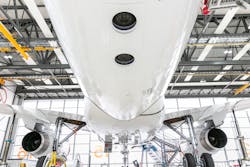Maintaining aircraft can be challenging work, without the missile systems. Maintaining military aircraft and their specialized systems can be an entirely different battle.
Retired USAF Lt. Gen. John Cooper, AAR senior vice president Integrated Solutions – Government, said AAR is a provides logistics and aviation support solutions to governments and militaries world-wide and support is organized around four major areas:
New parts sales: AAR provides factory new parts to the Defense Logistics Agency (DLA) and other governments supporting their military platforms.
Used parts, and whole engines and aircraft sales: AAR provides FAA certified parts, and also sell whole aircraft and engines.
MRO Services: AAR is the largest independent aircraft MRO in North America, overhauling >1,000 commercial and military aircraft annually. They have six MRO campuses in North America, and also have a military aircraft MRO campus in Poland. AAR also overhauls landing gear for most aircraft, and overhauls numerous critical components for military aircraft, with locations in both the US and Europe.
Integrated Solutions: AAR creates value-based Contract Logistics Support (CLS) Solutions designed to satisfy our customers’ needs. These solutions vary from warehousing support to boots-on-the-ground maintenance, supply, and BOS support around the world and in all conditions.
“AAR has worked on all manner of military aircraft, engine and components. Types of aircraft we currently support with parts or repair include P-8, C-40, C-130, F-16, UH-1N, H-60, CH-47, KC-46, KC-135, E-3,” Cooper continued.
While some designed only for military use, others are based on their commercial cousin, such as the P-8, whose airframe is designed from a Boeing 737.
“For all, probably the biggest difference is that they are significantly modified with mission systems designed for combat and contingency operations and they are all designed for more rigorous flying in combat scenarios,” continued Cooper.
Michael Lagemann, spokesperson, Lufthansa Technik AG, said the aircraft they currently are or soon will be servicing include: Airbus A350 for the head-of-state / political-parliamentary transport role; Airbus A321LR for troop transport / political-parliamentary flights; Airbus A321LR “Open Skies” reconnaissance aircraft; Airbus A340, A321, A319 for political-parliamentary transport and MedEvac; Bombardier Global 6500-based SIGINT aircraft; and the Boeing P-8A Poseidon maritime patrol aircraft. The latter of which is for the Royal New Zealand Air Force with the rest being under the German Air Force.
“As you can see in the list above, we are currently almost exclusively working on military derivatives of civilian aircraft models. However, it is a strategic goal of our company to further increase our share of the defense market. In doing so, we are planning to expand our portfolio beyond aircraft based on civilian airliner types.
"A first example of this will be the CH-47 Chinook. For the planned German procurement of this heavy-duty transport helicopter, we joined the supporting industry team through an MoU signed last year . The German Navy also plans to procure up to eight aircraft of the P-8A Poseidon type, for which we have signed a MoU for the strategic sustainment,” Lagemann said.
Fixing the Fleet
AAR performs different types of maintenance from flightline launching and recovering, to intermediate hangar maintenance, to major MRO – major tear down and rebuild of an aircraft.
“We also install modifications to aircraft, often including intrusive procedures like adding components or cutting into airframes. We also repair combat damage as needed,” said Lagemann.
The greatest difference these specialized machines will have over their civilian aircraft counter parts is the rigorous nature of flight they perform, which Lagemann said does drive repair requirements. However, he believes the biggest difference is the age of these military systems.
“The average age of commercial airlines is roughly 13 years old. Many military aircraft fleets average an age of 30 years or more imagine maintaining a new car versus a 30-year-old car. Combine that with the high intensity requirements and it makes for lots of additional maintenance needs,” Lagemann said.
Depending on the service AAR provides, there are daily, and scheduled maintenance requirements. Most aircraft are on a cycle or calendar requirement.
In addition, each aircraft will require some form of specialize tools, depending on the mission systems, and sometimes the fuselage requirements.
“Equipment required for MRO needs is substantial, and a major investment from our company to support MRO ops,” he said.
Lagemann noted the age of aircraft impacts the tools needed to perform some types of maintenance.
“Sometimes on their sheer age: During the maintenance of the SOFIA telescope, we, for example, had to remove its ancient JT9D engines that have become a real rarity these days. We could count us lucky that we still possessed the required equipment that other, less-specialized, MRO providers had already scrapped,” he said.
Many other repairs will be mission dependent, with aircraft having different parts from one another to complement the roles they play.
“Some installations can be purpose-built, or purpose-modified, for each individual special mission. As the name might suggest, some special mission aircraft serviced here at Lufthansa Technik are even once-in-a-lifetime projects for a unique use case. The MRO requirements for these components or modification thus often also strongly depend on the special, sometimes unique, mission our customers are flying with these aircraft,” said Lagemann continued.
With Lufthansa only currently servicing military derivatives of airliners, the regular maintenance schedules for airframe, engines or components are largely comparable, as are the training requirements.
“Through decades of experience with the maintenance, repair and overhaul of commercial airliners of almost all western-built types, we are renowned experts in safeguarding the highest possible aircraft utilization rates. This expertise can also play to its strengths for operators of the military derivatives of the said commercial airliners.
"The Boeing P-8A based on the 737. In the support for the RNZAF, our Total Component Support (TCS) covers more than 400 commercial common parts of the Boeing 737 that are also included in the military configuration P-8A. Leveraging the 737 commercial market in this way makes sense for smaller fleets as it allows easier access to necessary supply chain inventories such as our worldwide TCS spare parts pool network,” Lagemann said.
Cooper said that planning is critical.
“The flying schedule for commercial airlines involves known routes and schedules, while the military fleets' schedules vary significantly due to training requirements, as well as pop-up contingencies, humanitarian support, or political support. Planning is key for both commercial and military, however the military planning involves many uncontrollable variables which drive further maintenance requirements,” he explained.
Some of the principles needed to repair military craft and be applied to their civilian sisters.
“Two major practices provide for effectively maintaining military fleets; effective planning, and maintaining a competent workforce. Both take significant investment of time and money to ensure the ever-changing requirements for military fleets are planned and funded in advance, and that when the aircraft needs maintenance a competent workforce is ready to fix it,” Cooper said.
About the Author
Walker Jaroch
Editor
Contact: Walker Jaroch
Editor | AMT
+1-920-568-8399
>> To download the AviationPros media kits, visit: Marketing Resource Center
>>Check out our aviation magazines: Ground Support Worldwide | Airport Business | Aircraft Maintenance Technology

